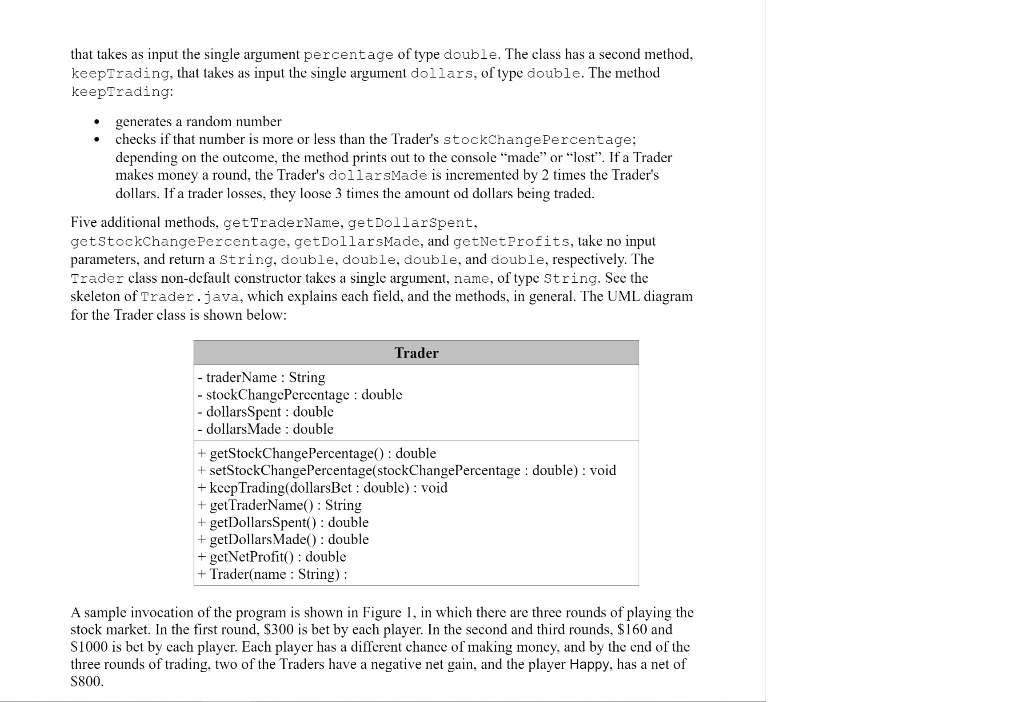

that takes as input the single argument percentage of type double. The class has a second method, keepTrading, that takes as input the single argument dollars, of type double. The method keepTrading: generates a random number checks if that number is more or less than the Trader's stockChange Percentage: depending on the outcome, the method prints out to the console "made" or "lost". If a Trader makes money a round, the Trader's dollarsMade is incremented by 2 times the Trader's dollars. If a trader losses, they loose 3 times the amount od dollars being traded. Five additional methods, getTraderName, getDollarspent, getStockchange Percentage, getDollarsMade, and getNet Profits, take no input parameters, and return a String, double, double, double, and double, respectively. The Trader class non-default constructor takes a single argument, name, of type String. See the skeleton of Trader.java, which explains each field, and the methods, in general. The UML diagram for the Trader class is shown below: Trader - trader Name : String - stockChangePercentage: double dollars Spent : double - dollars Made: double + getStockChangePercentage(): double + setStockChangePercentage(stockChangePercentage : double) : void + keep Trading(dollarsBet : double): void + getTraderName(): String + getDollarsSpent(): double + getDollars Made(): double + getNetProfit(): double + Trader(name : String): A sample invocation of the program is shown in Figure 1, in which there are three rounds of playing the stock market. In the first round, $300 is bet by each player. In the second and third rounds, $160 and S1000 is bet by cach player. Each player has a different chance of making money, and by the end of the three rounds of trading, two of the Traders have a negative net gain, and the player Happy, has a net of S800. that takes as input the single argument percentage of type double. The class has a second method, keepTrading, that takes as input the single argument dollars, of type double. The method keepTrading: generates a random number checks if that number is more or less than the Trader's stockChange Percentage: depending on the outcome, the method prints out to the console "made" or "lost". If a Trader makes money a round, the Trader's dollarsMade is incremented by 2 times the Trader's dollars. If a trader losses, they loose 3 times the amount od dollars being traded. Five additional methods, getTraderName, getDollarspent, getStockchange Percentage, getDollarsMade, and getNet Profits, take no input parameters, and return a String, double, double, double, and double, respectively. The Trader class non-default constructor takes a single argument, name, of type String. See the skeleton of Trader.java, which explains each field, and the methods, in general. The UML diagram for the Trader class is shown below: Trader - trader Name : String - stockChangePercentage: double dollars Spent : double - dollars Made: double + getStockChangePercentage(): double + setStockChangePercentage(stockChangePercentage : double) : void + keep Trading(dollarsBet : double): void + getTraderName(): String + getDollarsSpent(): double + getDollars Made(): double + getNetProfit(): double + Trader(name : String): A sample invocation of the program is shown in Figure 1, in which there are three rounds of playing the stock market. In the first round, $300 is bet by each player. In the second and third rounds, $160 and S1000 is bet by cach player. Each player has a different chance of making money, and by the end of the three rounds of trading, two of the Traders have a negative net gain, and the player Happy, has a net of S800








